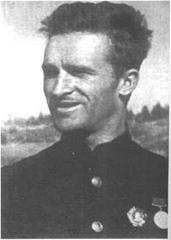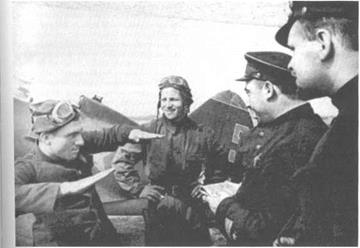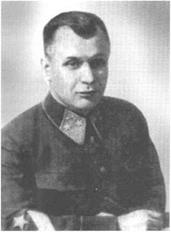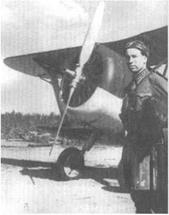Air War Over the Baltics
|
I |
n the northern combat zone, Luftflotte 1 had crippled WS-Northwestern Front badly during the fateful days in June. Records reveal that between June 22 and June 30, WS-Northwestern Front lost 425 aircraft during combat missions, 465 destroyed on the ground, and 187 with serious battle damage. Out of 403 SB bombers at hand on June 22, 205 had been shot down, 148 destroyed on the ground, and 33 damaged by June 30. Fighter losses included 1101-153s, 81 I-16s, and 17 MiG – 3s in the air.1
By July 1 the German Army Group North had reached Daugava River, which cuts Latvia in half, on a broad front and was prepared to launch a major offensive across the river. All Soviet attempts to halt the enemy at this point were futile. A renewed Soviet effort to counterattack, involving strong tank forces, was stymied by heavy air attacks undertaken by the medium bombers of Fliegerkorps I and about forty’ Bf 110 Zerstorern of ZG 26, recently brought in to Daugavpils from Luftflotte 2. More than 250 tanks were reportedly destroyed.
As the bomber units of the Northwestern Front, the WS of the Red Banner Baltic Fleet (KBF) and the DBA’s 1 BAK allocated to this sector were heavily damaged, the Stavka ordered the air force of the Northern Front (located along the Finnish border and in the Leningrad sector) to deploy strong bomber forces against the German Panzergruppe 4. Shifted from Staraya Russa to the Velikaya sector, 2 SAD carried out the first raids against Daugavpils on July 1. Due to intense antiaircraft fire the operations met only limited success. 1I./JG 53 claimed ten and JG 54 claimed two victories on this day.
Early the next morning, Panzergruppe 4 attacked
from its bridgeheads east of the Daugava River and advanced in a northwesterly direction toward the old Russian border. The bomber units of WS-Northem Front were slow to fulfill their new mission to interdict the Daugava crossings, and heavy rains and low cloud ceilings hampered much of the planned air activity on July 2. Nevertheless, JG 54 claimed twelve victories in this area alone.
One of the Soviet planes brought down by the Grunherz fighters was the SB piloted by Starshiy Leytenant Pavel Markutsa of 44 SBAP, VVS-Northern Front. While on a reconnaissance mission west of the Daugava River, Markutsa’s lone bomber was bounced by five Bf 109s. The tail gunner claimed to have shot down one of the enemy fighters but w’as immediately afterward thrown out of his cabin by a large explosion caused by a full salvo of 15mm shells hitting the fuselage and wings. With the fragile Tupolev bomber on fire, the pilot decided to force-land behind enemy lines. Leaving his dead navigator in the cockpit of the crashed and burning bomber, Markutsa managed to make contact with a large group of Red Army soldiers of 749 Rifle Regiment, which had been left behind enemy lines during the retreat. Following five days of repeated skirmishes with enemy troops in the area, the Soviet bomber pilot and 312 of 749 Rifle Regiment’s soldiers managed to break through to the Soviet lines. Two weeks later, Markutsa was awarded with the Golden Star as a Hero of the Soviet Union. Back in action, he would not survive the year.
At this point the Soviet air commanders in this sector encountered the same problems with widely dispersed units that their German counterparts soon would run into. With the entrance of Finland into the war on the German side on June 25, WS-Northem Front had to divert some of its units, including 5 SAD and 41 BAD— both from WS Twenty-third Army—to the Gulf of Finland, considerably weakening opposition to Luftflotte 1 in the air.
The cream of 13 1AP/KBF—4 Eskadrilya and part of 1 Eskadrilya, supplemented by Kapitan Aleksy Antonenko and Leytenant Petr Brinko of the regimental staff—formed an aviation group assigned the task of providing the beleaguered garrison at Hanko with air support. Situated at the northwestern mouth of the gulf, the naval base of Hanko had been conquered by the Soviets after the Winter War. To neutralize this strategic point was a common interest of the Finns and the Ger-
|
|
Thirty-year-old Kapitan Aleksey Antonenko of 13IAP/KBF was one of tie most skillful Soviet fighter pilots when the war broke out. As a former flight trainer he participated as a fighter pilot against the Japanese at Khalkhin-Gol, where he achieved six shared victories. He was awarded with the Order of Lenin during the Winter War against Finland. On the morning of June 23,1941, Antonenko arrived at 13 IAP/KBF at Laksberg near the Estonian capital, Tallinn, as a pilot inspector. During lunch a Ju 88 reconnaissance plane appeared over Laksberg. Antonenko quickly scrambled without his flight cap or parachute and managed to shoot it down, thus scori ng the KB F’s first victory of the war. According to a Soviet account, Antonenko calmly finished eating his plate of soup. In the following weeks, he successfully teamed with Leytenant Petr Brinko over the beleaguered naval base at Hanko in the Gulf of Finland. (Photo: Seidl.)
mans. But the KBF’s 13 IAP was an experienced, crack unit, counting some of the finest Soviet fighter pilots at that time. Notable among them were Aleksey Antonenko and Petr Brinko. Both would develop into the leading Soviet fighter aces in a matter of weeks. Equipped with 1- І 6s and 1-153s, this unit fought vehemently to defend Hanko against the Finnish assault forces. Leytenant Brinko opened his scoring record by claiming one fighter on July 3 and a Ju 88 on July 4.
In the Baltics, the units under command of Fliegerkorps I, were moved forward to bases in the
|
|
Pet’ Brinko started his career in the Soviet Navy Air Force in 1935. By the time the war with Germany and Finland commenced in 1941, Brinko had already amassed considerable combat experience as a fighter pilot at Lake Khasan and Khalkhin-Gol, as well as in the Winter War. On July 2,1941, the commander of 13 IAP/KBF transferred the team of Antonenko and Brinko to Hanko with the special aim of intercepting enemy reconnaissance planes. Brinko opened his World War II victory list by claiming a Finnish Bristol Bulldog over Hanko on July 3. Next day, Brinko and Antonenko together blew a Ju 88 out of the air in the same area. On July 14, Brinko and Antonenko were both listed as Heroes of the Soviet Union. At the time of his death on September 14,1941, Petr Brinko was the top-scoring Soviet fighter pilot, with a total number of fifteen victories. (Photo: Kabanov.)
Daugavpils-Riga area. “We were transferred to Mitau, an airfield littered with Soviet bomber wrecks, the remnants of an enemy unit that recently had been completely wiped out during a raid by our II. Gruppe," recalls Hauptmann Gerhard Baeker of 1I1./KG 1. These Kampfgruppen shifted their operations mainly to the interdiction of Soviet retrograde movements.
Particularly effective attacks were carried out by KG 1 Hindenburg. For two days, Soviet air activity remained very limited in this area. The pilots of JG 54 flew all daylong on July 3 without sighting any enemy aircraft The Ju 88 piloted by Leutnant Friedrich Kohl did not have the same fortune. The radio operator of this aircraft later reported to a Luftwaffe officer: “We came under attack from six enemy fighters. Our left engine was set on fire and we had to force-land in hostile territory. The Soviets captured three members of the crew. An Unteroffizier was strangled, and 1 don’t know what happened to the pilot and the other Unteroffizier. I was able to hide in a rye field, and later I could break through to German territory during constant fire from both sides. It is a pure miracle that I am still alive.”2
Reconnaissance crews of 5.(F)/122 reported the concentration of large Soviet air units to the east of the Russian-Latvian border. This was the buildup of General-Mayor Aleksandr Novikov’s VVS-Northern Front. At 0500 hours on July 4, the Ju 88s of KG 76 and KG 77 were dispatched against air bases at Idritsa and Opochka. Major Hannes Trautloft, the Geschwader – kommodore of JG 54 that escorted the bomber mission,
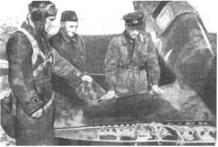
 wrote in his diary: “The bombs were dropped with precision at Opochka and several aircraft were seen burning on the ground. At Idritsa the bombs went down across the runway without inflicting any considerable damage. Some l-18s scrambled. Our fighters shot down one of them in flames.”
wrote in his diary: “The bombs were dropped with precision at Opochka and several aircraft were seen burning on the ground. At Idritsa the bombs went down across the runway without inflicting any considerable damage. Some l-18s scrambled. Our fighters shot down one of them in flames.”
Raiding an air base near Dno, farther to the north, ZG 26 lost a Bf 110 in a taran conducted by a MiG-3 piloted by Mladshiy Leytenant Aleksandr Lukyanov of 159 1AP/2 SAD. During renewed air-base raids later in the day, the raiders were repeatedly intercepted by small groups of scrambling fighters from 2 SAD and 39 1AD. Oberleutnant Hans Philipp, the Staffelkapitan of 4./JG 54, returned from one of these engagements with his thirty-first, thirty-second, and thirty-third confirmed victories.
Late in the afternoon of July 4, the situation in the air completely changed as Novikov’s bombers were launched for the first time en masse against the advancing Panzergruppe 4. The Bf 109s of Fliegerkorps I rose in full scale, and the carnage above Daugavpils on the last day of June was repeated. At the end of the day the German fighters had claimed forty-six Soviet aircraft, mainly bombers. During a single engagement, Messerschmitts bagged twenty of twenty-five Soviet bomb
ers attempting to attack the advancing German tanks. Another fire taran was conducted by Kapitan Leonid Mikhailov, piloting an SB at the head of an Eskadrilya from 10 SBAP/41 BAD.
On July 5, Army Group North established a bridgehead over the Velikaya River at Ostrov, south of Lake Peipus, having advanced 225 miles in only three days. The Soviet Northwestern Front mounted a heavy counterattack in this area, but it was met by effective attacks carried out by the Ju 88s of KG 1, KG 76, and KG 77. The German bombers were concentrated against three main targets: close-support missions at Ostrov, inderdiction raids against retrograde movements at Pskov in the north, and the airfields of the VVS. The successes were immense. Against only two homber losses, 140 Soviet tanks were destroyed, virtually all Soviet supply lines to the Ostrov sector were cut off, and 112 Soviet aircraft were claimed destroyed on the ground.
Scrambled against new’ large waves of incoming Soviet bombers, Il./JG 53 and JG 54 Griinherz were credited with a further twenty-one Soviet aircraft destroyed in aerial combat on July 5. Hauptmann Arnold Lignitz, the Gruppenkommandeur of 11I./JG 54, and his Leutnants Max-Hellmuth Ostermann and Hermann Leiste contributed to these successes by downing three Soviet planes each.
During one of the intense air combats on this day, Hauptmann Lignitz’s Gruppe encountered the new Soviet Yak – 1 fighters of 12 1AP. Starshiy Leytenant Pavel Tarasov of the latter unit was credited with the destruction of three Bf 109s, the last brought down in a taran that Tarasov was fortunate to survive.3 Pavel Tarasov went on to claim a total of 25 aerial victories in 235 combat sorties before he was killed three years later.
The Soviet attempt to halt the Germans at the “Stalin Defense Line” on the old Russian border with the Baltic states w’as a complete failure. On the other hand, the task of Luftflotte 1 to block the Soviet retreat—and thus create the conditions for surrounding the troops of the Soviet Northwestern Front-failed. 1 Even if large amounts of Soviet materiel ■; were destroyed during these missions, the
main bulk of the Northwestern Front managed to escape to “old Russia” through a rapid retreat.
At this point, Panzergruppe 4 advanced swiftly toward Leningrad. General-Mayor Novikov had no other option but to sacrifice his savagely beaten air units in renewed attacks for the third day running, this time against the Velikaya bridges at Ostrov. According to German sources, seventy-three Soviet bombers were dispatched, few of which would return. JG 54 had another field day on July 6, claiming fifty-seven victories against five losses. By bringing down three, Oberleutnant Hans – Ekkehard Bob of 9./JG 54 increased his total score to twenty-nine.
Leutnant Max-Hellmuth Ostermann of 7./JG 54 achieved his nineteenth and twentieth kills, but he also witnessed how two of his fellow pilots were shot down in a row. Three 1-16 pilots led by Starshiy Leytenant Aleksey Storozhakov of 154 1AP claimed an extraordinary success during what might have been the same combat in which 7./JG 54 lost Leutnant Helmut Biederbick and Unteroffizier Theodor Steinwendtner. Covering a formation of SBs against nine intercepting Bf 109s, the three 1-16s claimed three German fighters shot down without losses.
The bombers of Fliegerkorps 1 made a major attempt to thwart Novikov’s attempts on the ground, striking at several airfields between Lake Peipus and Lake Ilmen. While raiding an air base in the vicinity of Lake Ilmen, Unteroffizier Willi Bukowski’s ju 88 of 6./KG 1 was destroyed in a ramming by Mladshiy Leytenant Afanasiy Okhvat’s MiG-3.
A final attempt by the Soviets to disturb the German threat against Leningrad through mass attacks by medium bombers on July 7 resulted in another forty-six planes claimed shot down by JG 54—including the 750th victory of the Geschwader. With two of these planes, Oberleutnant Hubert Miitherich, Staffclkapitan in 5./JG 54, became next to reach his personal twentieth victory.
In total, the VVS carried out 1,200 sorties, dropping 500 tons of bombs against the German armored columns in the Ostrov sector between July 1 and July 10. But the large-scale air raids in the first week of July almost completely obliterated the VVS bomber units in the northern combat zone Between July 4 and July 9, 2 SAD and 41 BAD alone registered sixty aircraft losses.4
In order to improve command and control, the Stavka implemented a centralized structure on July 10. Three new supreme commands were created: the Northwestern Zone, comprising the Northern and Northwestern fronts; the Western Zone, comprising the Western Front; and the Southwestern Zone, comprising the Southwestern and Southern fronts.
Overall command of the army air forces in the Northwestern Zone was entrusted to General-Mayor Novikov. Novikov, who would rise to command the entire WS within a year, soon drew conclusions regarding the bitter defeats in the air produced by the use of unescorted medium bombers operating in large formations in daylight. The bomber missions were mainly shifted to night operations, a far less hazardous business due to the lack of effective German night fighters. In daylight, all bomber missions were to be provided with fighter escort. In general, Novikov placed an increasing reliance on his fighter units. He called for a more aggressive stance against enemy aircraft. On top of this, the VVS fighter units were called on to carry’ out incessant, swift, low-level harassment attacks against the German ground troops.
By July 10 the battered WS-Northwestern Front was left with only 102 aircraft of the 1,142 it had on hand at the outbreak of the war. But together with the air forces of the KBF and the Northern Front, the Northwestern Zone nevertheless could muster a total of 1,300 combat aircraft, including a force deployed along the Finnish border. Luftflotte 1, down to about 350 aircraft in mid-July, was once again up against a numerically superior enemy.
After the victory at Ostrov, the Germans ran into a gradually stiffening Soviet resistance. The advance of Army Group North slowed down considerably, particularly in the marshlands between Lake Peipus and Lake Ilmen, where Panzergruppe 4 struggled to the northeast, toward Leningrad.
The shift in the WS tactics was increasingly felt among the German ground troops. The slow-moving motorized columns were subjected to incessant low-level air raids, particularly from 41 BAD and 39 LAD. Already on July 8 and 9, the German XXVI Corps complained to Luftflotte 1 about increased Soviet air attacks. In Estonia, the advance from the south by the German Eighteenth Army was severely handicapped by Soviet fighter patrols, which made Luftwaffe reconnaissance flights extremely hazardous.
On the other shore of the Gulf of Finland, the Red
|
|
General-Mayor Aleksandr Novikov, the commander of VVS-Northem Front, was the only VVS commander in the western regions of the USSR to survive the wave of purges that followed on the disaster of June 1941. Under his proficient command, the Soviets were able to regain their strength in the air prior to the German attack against Leningrad. In 1942, Novikov rose to command the entire WS. (Photo: Novikov.)
Banner Baltic Fleet’s 13 IAP, in Hanko, put up a gallant Fight against both Finnish and German air intrusions. On July 8, Leytenant Petr Brinko bagged a Do 17 from 3.(F)/10. The aircraft was salvaged by the Soviets and put on display in the central square of Hanko.
Here the Finnish fighter group LeLv 6 launched a modern variant of the “Trojan Horse" when two 1-153s captured during the Winter War were used on reconnaissance missions over the western part of the Gulf of Finland. On July 10 a Soviet 1-153 and a MiG-1 attacked these two war trophies north of Hanko, resulting in the death of Finnish Yliluutnantti (Senior Lieutenant) V. Kallio, piloting the 1-І53.’
While the bombers of Luftflotte 1 were employed mainly against Russian rail traffic in the Estonian territory and on the Moscow-Leningrad railroad, the Soviet fighters grew’ increasingly troublesome to the Germans.
On July 10 a Ju 88 formation from KG 1 Hindenburg was intercepted by six I-16s from 154 IAP, resulting in Leytenant Sergey Titovka bringing down the bomber piloted by Feldwebel Paul Kcmpf, through ramming. In total, 154 IAP claimed sixteen victories this day, while KG 1 registered three Ju 88s lost. The missions on July 11 cost KG 77 three Ju 88s. The next day, Leytenant Mikhail Antonov of 19 LAP destroyed the Ju 88 piloted by Feldwebel Hans Figge of 3./KG 76.
Even though Fliegerkorps I claimed that it had shot down 487 Soviet planes in the air and destroyed 1,211 on the ground between June 22 and July 13, resistance in the air was mounting. On July 11 and 12, Soviet airmen claimed to have put fifteen tanks and ninety armored vehicles out of commission and destroyed two bridges in the area southeast of Lake Peipus. This aggressiveness on the part of the Soviet aviation units compelled the Germans to return repeatedly to new air-base raids.
While escorting Ju 88s against a Soviet airfield in the Novgorod region near Lake Ilmen on July 13, Oberleutnant Gerhard Ludwig of l./JG 54 collided with Leytenant Aristotel Kavtaradze of 38 LAP, and both pilots were killed. Enemy air rammings became a particular preoccupation to the airmen of Luftflotte 1 during this period of the war. In fact, more than half of the forty-nine tarans registered by the VVS during the month of July 1941 were carried out in the northern combat zone alone.
While General Helmuth Forster, the commander of Fliegerkorps 1, concentrated the bulk of his fighters to the area east of Lake Peipus, VVS-KBF made a skillful use of its weakened bomber forces over the Gulf of Riga, in the west, on July 13. Eighteen DB-3s and five Ar-2s (the dive-bomber version of the SB bomber) struck against a large German seaborne supply convoy, claiming one transport vessel sunk and eight damaged.6
In mid-July the exhausted tank soldiers of Panzergruppe 4 reached the Luga River, sixty miles from Leningrad. On July 14, as the town of Soltsy, to the west of Lake Ladoga, was seized, the Germans were beset by some of the heaviest Soviet air attacks encountered so far. General-Mayor Aleksandr Novikov had concentrated ] a force of 235 aircraft, including units from VVS – ] Northwestern Front, 2 SAD of the Northern Front, and ^ 1 BAK of the Long-Range Air Force, in this sector. All ■ of these units were dispatched in continous attacks against j


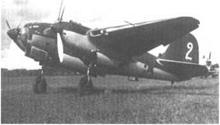
 enemy troops, tanks, and artillery batteries in the Soltsy region. This was the prelude to the counteroffensive mounted by General-Leytenant Aleksandr Matveyev’s Soviet Eleventh Army on July 14.
enemy troops, tanks, and artillery batteries in the Soltsy region. This was the prelude to the counteroffensive mounted by General-Leytenant Aleksandr Matveyev’s Soviet Eleventh Army on July 14.
With its supply lines strung out, this surprisingly heavy attack forced the decimated Panzergruppe 4 to halt its offensive. The battle around Soltsy raged for four days, during which the VVS carried out fifteen hundred close-support sorties. The long distance from their airfields considerably handicapped German fighters in this sector. Despite the strong commitments by Ju 88 and Bf 110 crews in this area, the Germans were pushed back twenty-five miles, with severe losses to the 8th Panzer Division.
On the right flank of Panzergruppe 4, the German Sixteenth Army advanced eastward to cut off the communications between Leningrad and Moscow, but it also ran into fierce resistance, which made every step forward difficult.
The Blitzkrieg in the northern combat zone had ended. Resistance was sharpening, both on the ground and in the air. The VVS was becoming increasingly active and aggressive, even though the Luftwaffe maintained its qualitative superiority.
The Soviet air forces of the Northern and Northwestern fronts claimed to have destroyed 628 enemy aircraft between June 22 and July 22. Even if this figure includes all claims, in the air as well as on the ground, along the entire combat zone from Murmansk in the Far North to the East Prussian border in the South, it must be regarded as a manifold exaggeration. JG 54 Griinherz had scored impressively, achieving 500 victories between June 22 and July 18.
This figure roughly matches the actual WS losses of 372 aircraft in WS-North – ern Front from June 22 to July 22, and 563 shot down in VVS-Northwestern Front through the end of July. To these figures should be added the losses suffered by the KBF and the DBA. During the same period, June 22 to July 18, more than thirty Bf 109s, around one-third of the entire Jagdgeschwader, had been shot down. In the bomber units of Fliegerkorps 1, KG 1 registered sixteen
losses, KG 76 registered nineteen, and KG 77 lost twenty – four Ju 88s.7
The combat attrition rapidly wore down the strength of the Luftwaffe units. Improvisation—even if it meant breaking some rules—was imperative. Hauptmann Gerhard Baeker, the technical officer in 1I1./KG 1 at this time, told the authors: “The burden laid on a technical officer in a flying unit on the Eastern Front was very heavy. The supply lines grew more extended and it grew increasingly difficult to receive spare parts. Every force – landed aircraft had to be plundered of useful parts (even if this, of course, was not allowed!), but my task was to bring serviceable aircraft into operation. I continually flew my Me 108 (Taifun) or took a car to most of the bellied Ju 88s, indicated the way to the ecash site to our technicians, and earmarked reserve spare parts.”
Under able command, the VVS now proved to be able to adapt itself to new situations with a flexibility uncharacteristic of Stalinist policy. The new stress on Soviet fighters rapidly provided the invaders with mounting difficulties. This became a main preoccupation to the German ground troops, who became subject to continous strafing and bombing from fast-flying fighter-bombers dropping out of the clouds. This would become an important benchmark of the entire war on the Eastern Front. This dominant ground-support air doctrine, in fact, emerged spontaneously from the shortcomings of the Soviet light and medium bombers during the initial weeks of the war.
Higher quality on the German side had produced impressive results, but it could not overcome the superior Soviet resources in the long run.
The most spectacular result of the war in the northern combat zone during the first four weeks of hostilities was that Army Group North had succeeded in one important operational goal—seizure of the Baltic states— without achieving its main strategic goal, annihilation of
|
|
This WS starshiy leytenant, posing in front of an 1-15bis, symbolizes the determination with which the Soviet airmen fought in the difficult days of 1941. The 1-15bis proved to be more or less a "flying coffin" during the air war against modern Luftwaffe aircraft types. Burdened with fixed landing gear and powered by a 750-hp M-25V engine, it could fly not faster than 234 mph. Although vulnerable to hostile fire, it was used extensively in the ground-attack role. The normal bomb load, however, did not consist of more than four 25-kg or 32-kg bombs mounted in four underwing racks. (Note the plain upper wing, without the gull-like struts that characterized the 1-153.) (Photo: Seidl.)
the Soviet Northwestern Front. The withdrawal of an entire Soviet army group from an area with a mainly hostile population without being surrounded by the rap idly advancing German armored units was a remarkable feat.











